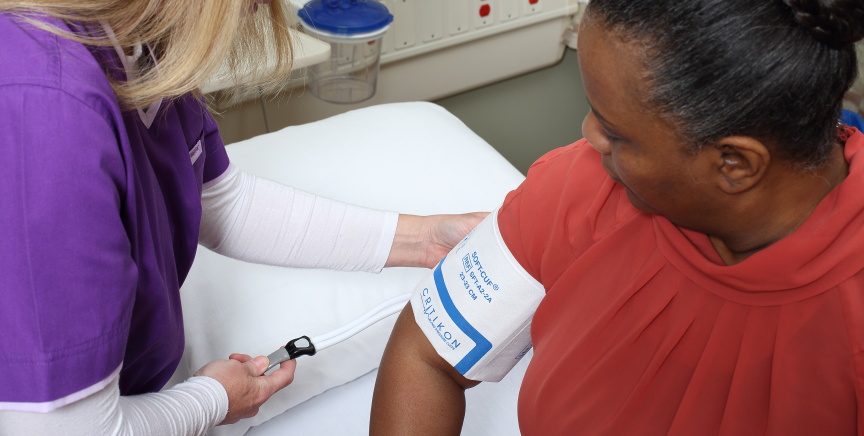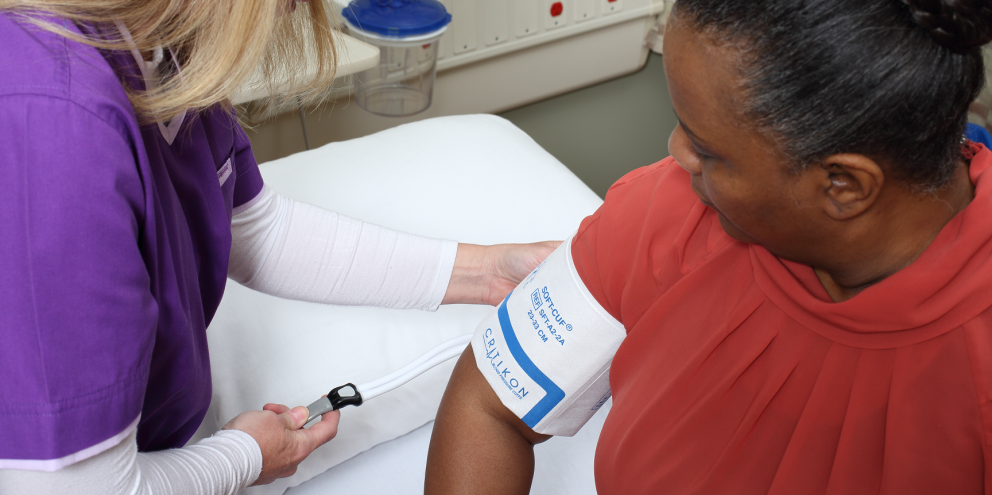
Thanks to the pivotal Framingham Heart Study, it was discovered that isolated systolic blood pressure elevation rather than diastolic hypertension is associated with an increased risk for coronary artery disease (CAD). 3 The Framingham investigators stated in their research that “neither the systolic and diastolic pressure measurements in combination nor the pulse pressure and the mean arterial pressure measurements alone discriminated better than [did] the systolic measurement alone.”3 One of the most interesting and significant realizations made in the Framingham Heart Study was the importance of pulse pressure, or the difference between systolic and diastolic blood pressure, with regard to cardiovascular risk. Contrary to prior beliefs, a lower diastolic pressure along with an elevated systolic pressure signal the presence of more severe atherosclerotic disease with worse outcomes when compared with a scenario of congruent diastolic and systolic elevations.
The significance of hypertension in the bigger picture of cardiovascular disease is clear. Recently, a panel of experts convened in an effort to address the barriers to controlling the global epidemic of hypertension. In addition to focusing on poor medication compliance, the panel called for the expansion of blood pressure monitoring, underscoring the importance of being able to perform easy and accurate blood pressure measurements.4
In the perioperative period, hypertension is the most common reason for postponing surgery.5 It has been suggested that an elective surgery should be canceled if the patient’s systolic blood pressure is 180 mmHg or higher or if their diastolic blood pressure is 110 mmHg or higher.6,7 A range of pharmacologic treatments exist for controlling blood pressure both long-term and perioperatively. The choice of drug largely depends upon a patient’s comorbidities. Individuals with CAD are often on β-blockers and angiotensin pathway drugs preoperatively. Evidence supports the continuation of β-blockers perioperatively; conversely, while continuing angiotensin-blocking drugs is not associated with increased mortality after non-cardiac surgery, many clinicians believe angiotensin-blocking drugs should be held preoperatively due to an increased risk for intraoperative hypotension.8 When acute surgical hypertension is present or persists into the postoperative period, use of a short-acting, easily titrated intravenous medication is preferred. Commonly used drugs for the management of postoperative surgical hypertension include intravenous nitroglycerin, sodium nitroprusside, β-blockers, hydralazine, and calcium channel blockers.9
Hypertension is common in patients presenting for non-cardiac surgery. For the most part, hypertension exists without symptoms, which has led to an increased likelihood of it being discovered only during the preoperative assessment rather than well before it. Studies have shown the incidence of preoperative hypertension to range from 10% to 25%.10 When confronted with a hypertensive patient, the anesthesiologist must consider two questions, as follows: (1) should the diagnosis or detection of hypertension lead to further testing and/or postponement of the planned surgery and, (2) if surgery does proceed, what would be the expected outcome of the patient's perioperative course? Without clear data, it is ultimately up to the clinician to decide based on the patient’s comorbidities, the urgency of the procedure, and the postoperative disposition whether to proceed or not.
In a recent landmark study published in the journal Anesthesiology, Monk et al. looked at a large sample of patients from the United States Veterans Affairs system and found that intraoperative hypotension but not hypertension was associated with increased 30-day mortality as well as directly related with the magnitude and length of time the patient experienced low blood pressure.11 Elsewhere, Howell et al. confirmed through a meta-analysis that, when organ damage is not present, hypertension alone cannot be linked to increased perioperative risk.6
There is no doubt that blood pressure monitoring during the delivery of anesthesia is of vital importance. Although invasive arterial pressure monitoring may be preferred in selected patients, the vast majority of those undergoing non-cardiac surgery will have noninvasive cuff pressures recorded throughout their procedure. Accuracy, reproducibility, and reliability in monitoring modalities are required to ensure optimal patient outcomes. To this end, GE Healthcare’s noninvasive blood pressure (NIBP) solutions offer clinicians an innovative monitoring system capable of maintaining the accuracy and reliability that complex patients demand.
GE Healthcare’s NIBP cuffs occlude and slowly release an artery while sensing pressure pulses and converts those pulses into a pneumatic signal. The accuracy of the blood pressure reading is closely dependent on the appropriate cuff size being used. The American Heart Association recommends that the cuff bladder width and length be 40% and 80% of the arm circumference, respectively. With a wide range of patient arm sizes and obesity of the upper arm sometimes preventing a proper fit, GE Healthcare offers not only a wide range of cuff sizes but also a forearm radial artery cuff, allowing the clinician to tailor their selection of the right cuff for the right patient. In addition, the GE SmartMix™ cuff offering improves workflow and lowers costs while allowing for proper utilization, offering single short-term, limited-reuse, hospital-reusable, and long-term use solutions.
Another key feature of GE Healthcare’s NIBP system is systolic searching, one of several enhancements found in the DINAMAP SuperSTAT blood pressure algorithm. Incorporating fewer deflation steps and offering rapid reinflation, the SuperSTAT algorithm yields accelerated determinations, which are more accurate across a wide range of blood pressures.12 With this stepped deflation method, based on the patient’s actual pulse, SuperSTAT is able to determine blood pressure values even at low pulse rates. This is particularly important during periods of low blood pressure when traditional cuffs are often unable to yield an accurate reading. This increased sensitivity with the SuperSTAT algorithm is achieved with a two-tube inflation and monitoring system where the inflation line and the sensing line are separate from one another. In addition to being fast and accurate, SuperSTAT is able to assess the consistency of the pulse shape in an effort to filter out motion artifacts. Finally, the SuperSTAT algorithm is able to increase the reliability and accuracy of measurements during irregular cardiac rhythms by utilizing data from the electrocardiogram signal to compare with blood pressure oscillations.12
In conclusion, clinicians demand a high level of excellence in their practice and should require the same of the tools they use to care for patients. GE Healthcare's NIBP technology found across all GE Healthcare's monitoring systems along with the SuperSTAT algorithm empower anesthesiologists by offering a cuff for every patient while providing increased speed, sensitivity, and accuracy, even during pressure extremes.
References
- Lim SS, Vos T, Flaxman AD, et al. A comparative risk assessment of burden of disease and injury attributable to 67 risk factors and risk factor clusters in 21 regions, 1990–2010: a systematic analysis for the Global Burden of Disease Study 2010. 2012;380(9859):2224–2260. DOI: 10.1016/S0140-6736(12)61766-8. Accessed June 25, 2019.
- Lewington S, Clarke R, Qizilbash N, Peto R, Collins R, Prospective Studies Collaboration. Age-specific relevance of usual blood pressure to vascular mortality: a meta-analysis of individual data for one million adults in 61 prospective studies. Lancet. 2002;360(9349):1903–1913. DOI: 10.1016/s0140-6736(02)11911-8. Accessed June 25, 2019.
- Franklin SS, Wong ND. Hypertension and cardiovascular disease: contributions of the Framingham Heart Study. Glob Heart. 2013;8(1):49–57. DOI: 10.1016/j.gheart.2012.12.004. Accessed June 25, 2019.
- Kahan T. Focus on blood pressure as a major risk factor. Lancet. 2014;383(9932):1866–1868. DOI: 10.1016/S0140-6736(14)60896-5. Accessed June 25, 2019.
- Dix P, Howell S. Survey of cancellation rate of hypertensive patients undergoing anaesthesia and elective surgery. Br J Anaesth. 2001;86(6):789–793. DOI: 10.1093/bja/86.6.789. Accessed June 25, 2019.
- Howell SJ, Sear JW, Foëx P. Hypertension, hypertensive heart disease and perioperative cardiac risk. Br J Anaesth. 2004;92(4):570–583. DOI: 10.1093/bja/aeh091. Accessed June 25, 2019.
- Fleisher LA. Preoperative evaluation of the patient with hypertension. JAMA. 2002;287(16):2043–2046. DOI: 10.1001/jama.287.16.2043. Accessed June 25, 2019.
- Fleisher LA, Fleischmann KE, Auerbach AD, et al. 2014 ACC/AHA guideline on perioperative cardiovascular evaluation and management of patients undergoing noncardiac surgery: executive summary: a report of the American College of Cardiology/American Heart Association Task Force on Practice Guidelines. Circulation. 2014;130(24):2215–2245. DOI: 10.1161/CIR.0000000000000105. Accessed June 25, 2019.
- Aronow WS. Management of hypertension in patients undergoing surgery. Ann Transl Med. 2017;5(10):227. DOI: 10.21037/atm.2017.03.54. Accessed June 25, 2019.
- Varon J, Marik PE. Perioperative hypertension management. Vasc Health Risk Manang. 2008;4(3):615–627. DOI: 10.2147/vhrm.s2471. Accessed June 25, 2019.
- Monk TG, Bronsert MR, Henderson W, et al. Association between intraoperative hypotension and hypertension and 30-day postoperative mortality in noncardiac surgery. Anesthesiology. 2015;123(2):307–319. DOI: 10.1097/ALN.0000000000000756. Accessed June 25, 2019.
- Friedman, Bruce. DINAMAP SuperSTAT algorithm: Setting target inflation, GE Healthcare whitepaper, JB25639XX, 2014.








